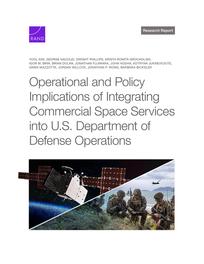Operational and Policy Implications of Integrating Commercial Space Services into U.S. Department of Defense Operations
ResearchPublished Feb 11, 2025
The use of commercial space services will increase in the next decade as technological advances make these services increasingly capable of supporting U.S. Department of Defense needs and augmenting its capabilities. Implications of these rising demands and congressional concerns about the integration of such services into military operations, including impacts on space operations and policy, are explored in this congressionally directed report.
ResearchPublished Feb 11, 2025

The U.S. Department of Defense (DoD) and the military services rely on a wide variety of space capabilities to carry out many of their missions — but the degree of use differs depending on the mission. The space industry is rapidly evolving with continual changes to markets, companies, and their offerings, and these market dynamics influence DoD decisions about the use of commercial space services, which is expected to increase in the next decade. Technological advances make these services increasingly capable of supporting DoD needs and providing valuable augmentation to the department's own systems and capabilities. Despite the benefits that commercial services can bring, DoD must consider the vulnerability of these commercial space services to adversary attack when determining how much to rely on them and what missions they should support. The research team explored six commercial space markets — satellite communications; space domain awareness; remote sensing; environmental monitoring; positioning, navigation, and timing; and space logistics — in this congressionally directed report, which focuses on the implications of these increasing demands for commercial space services on space operations and the national and international policy environment.
The research reported here was commissioned by the Assistant Secretary of the Air Force for Space Acquisition and Integration and conducted within the Resource Management Program of RAND Project AIR FORCE.
This publication is part of the RAND research report series. Research reports present research findings and objective analysis that address the challenges facing the public and private sectors. All RAND research reports undergo rigorous peer review to ensure high standards for research quality and objectivity.
This document and trademark(s) contained herein are protected by law. This representation of RAND intellectual property is provided for noncommercial use only. Unauthorized posting of this publication online is prohibited; linking directly to this product page is encouraged. Permission is required from RAND to reproduce, or reuse in another form, any of its research documents for commercial purposes. For information on reprint and reuse permissions, please visit www.rand.org/pubs/permissions.
RAND is a nonprofit institution that helps improve policy and decisionmaking through research and analysis. RAND's publications do not necessarily reflect the opinions of its research clients and sponsors.